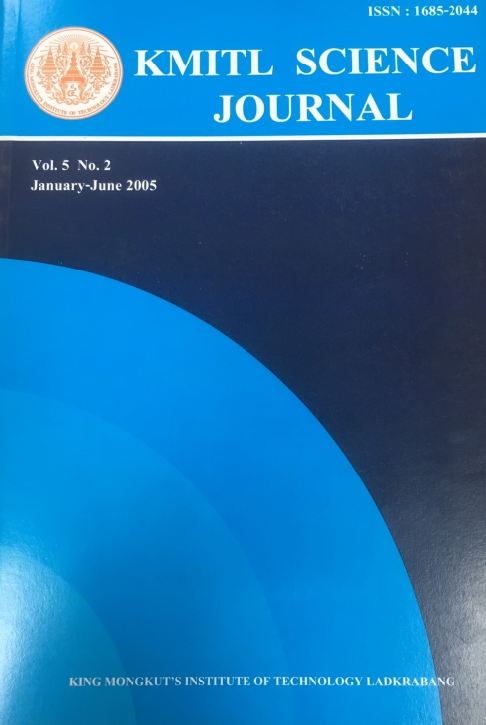Improved Method to Determine the Hardness and Elastic Moduli using Nano-Indentation
Main Article Content
Abstract
It is well known that hardness and elastic moduli can be determined by indenting the specimen to various depths. This paper shows the application of three application of three approximation approaches for this purpose: the ideal method, Sun’s method, and modified Oliver & Pharr’s method. A comparison of the results for silicon (100) and high speed steel (HSS) specimens in terms of hardness and elastic moduli has been made. In general, the results obtained from the Sun’s method are more stable and reliable than the other methods.
Keywords: Nanoindentation, load-displacement curve, hardness
Corresponding author: E-mail: panich@pmail.ntu.edu.sg
Article Details
Copyright Transfer Statement
The copyright of this article is transferred to Current Applied Science and Technology journal with effect if and when the article is accepted for publication. The copyright transfer covers the exclusive right to reproduce and distribute the article, including reprints, translations, photographic reproductions, electronic form (offline, online) or any other reproductions of similar nature.
The author warrants that this contribution is original and that he/she has full power to make this grant. The author signs for and accepts responsibility for releasing this material on behalf of any and all co-authors.
Here is the link for download: Copyright transfer form.pdf
References
[2] Doerner, M.F. and Nix, W.D. 1986 A Method for Interpreting the Data from Depth-sensing Indentation Instruments. Journal of Materials Research, 1, 601-606.
[3] Joslin, D.L. and Oliver, W.C. 1990 A New Method for Analyzing Data From Continuous Depth-sensing Microindentation Test. Journal of Materials Research, 5, 123-126.
[4] Woirgard, J. and Dargenton, J-C. 1997 An Alternative Method for Penetration Depth Determination in Nanoindentation Measurements. Journal of Materials Research, 12, 2455-2458.
[5] Oliver, W.C. and Pharr, G.M. 1992 An Improved Technique for Determining Hardness and Elastic Moduli using Load and Displacement Sensing Indentation Experiments. Journal of Materials Research, 7, 1564-1583.
[6] Bell, T.J., Bendeli, A., Field, J.S., Swain, M.V. and Thwaite E.G. 1992 The Determination of Surface Plastic and Elastic Properties by Ultra-Micro Indentation. Metrologia, 28, 463-469.
[7] Fischer-Cripps, A.C. 2000 UMIS II Brochure, CSIRO Telecommunications and Industrial Phsics.
[8] Sneddon, I.N. 1965 The Relation Between Load and Penetration in the Axisymmetric Boussinesq Problem for a Punch of Arbitrary Profile. International Journal of Engineering Science, 3, 47.
[9] Hainsworth, S.V., Chander, H.W. and Page, T.F. 1996 Analysis of Nanoindentation Load-displacement Loading Curves. Journal of Materials Research, 11, 1987-1995.
[10] Pharr, G.M., Oliver, W.C. and Brotzen, F.R. 1992 On the Generality of the Relationship Between Contact Stiffness, Contact Area, and Elastic Moduli During Indentation. Journal of Materials Research, 7, 613-617.
[11] Sun, Y., Zheng, S., Bell T. and Smith, J. 1999 Indenter Tip Radius and Load Frame Compliance Calibration using Nanoindentation Load Curves. Philosophica Magazine Letter, 79, 649-658.
[12] Cheng, Y.T. and Cheng, C.M. 1998 Further Analysis of Indentation Loading Curves: Effects of Tip Rounding on Mechanical Property Measurements. Philosophical Magazine Letter,77, 39.
[13] Nano Test-500, Micro Materials Ltd., Wrexham, United Kingdom.
[14] Peterson. 1982 Silicon as a Mechanical Material. Proc. IEEE Vol.7 No.5, pp. 420-475.
[15] Pharr, G.M. 1998 Measurement of Mechanical Properties by Ultra-low Load Indentation. Materials Science & Engineering A, 253, 151-159.
[16] Ketin, M., Fonderies, S.D. and Marichal K.J. 372 B-4000 Liège (Sclessin), Belgium.


